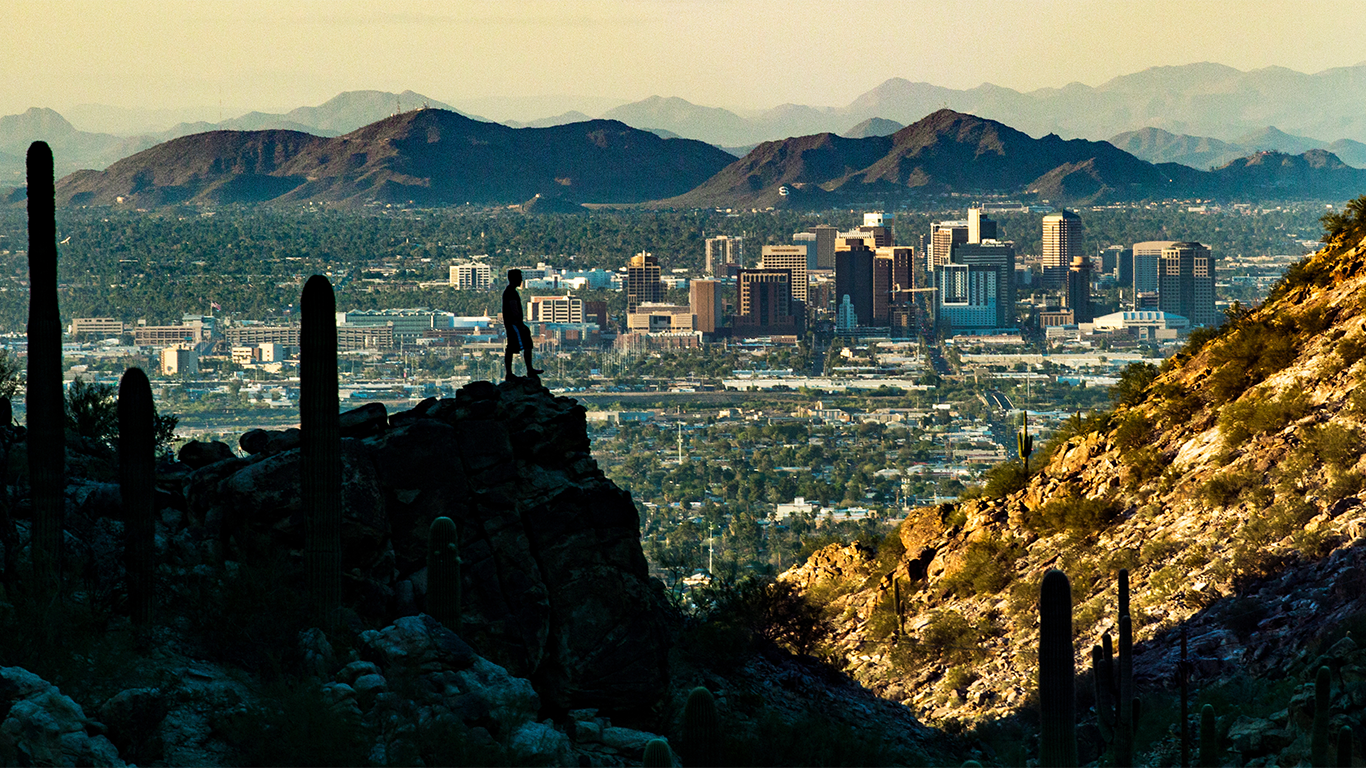For years, Arizona’s low cost of living and housing in Arizona made it a draw for people from all over the country.
But Arizona is no longer the state it once was.
According to a new Arizona State University study, the cost of living has increased and now surpasses the national average. And although new home construction hit a record high in 2023, the cost of housing outpaced increases in earnings, causing home purchases to decline 22% compared with 2022.
These and other troubling findings emerged from the newly released “State of Housing in Arizona Report” put out by ASU’s Morrison Institute for Public Policy and presented by a gathering of experts on Aug. 8 at the second annual Housing and Water Policy Summit at the Renaissance Downtown Phoenix Hotel.
The Morrison Institute is a nonpartisan think tank dedicated to producing objective research on critical policy issues. The public policy research institute is housed within ASU’s Watts College of Public Service and Community Solutions.
More than 200 people including elected officials from throughout Arizona attended the event.
The goal of the summit was to share data on two key issues: housing and water.
“These issues are undeniably the issues that are shaping our state’s economic trajectory and defining quality of life for all of our residents,” said Andrea Whitsett, executive director of the Morrison Institute. “They both demand our attention, and they will require long-term planning and smart management.”
DEEPER DIVE: Here’s where the residential real estate market stands in 2025
LOCAL NEWS: 100 best places to work and live in Arizona for 2025
INDUSTRY INSIGHTS: Want more news like this? Get our free newsletter here
Unveiling the report
Alison Cook-Davis shared key indicators and trends from the second annual report related to home ownership, rentals housing and homelessness.
“Rising home prices present a barrier to home ownership,” said Cook-Davis, research director at the Morrison Institute for Public Policy.
From 2010 to 2014, the typical home value in Arizona nearly doubled — a 91% increase after adjusting for inflation. By March 2024, the typical home price reached $427,272, while the median rent was $1,600.
Mobile and manufactured homes, which were typically one of the most affordable housing options in Arizona, also became a more expensive and inaccessible option.
While manufactured homes increased in price by 35% nationally (to about $61,000 since 2016), the cost of a new mobile home in Arizona rose by 80% from 2017 to 2022, to more than $160,000. Mobile home rentals increased from $400 a month in 2019 to more than $1,000 in some areas.
“Increase in home values has outpaced growth in homeowners’ household income,” said Cook-Davis, with housing values increasing about seven times faster than income increased between 2010 and 2023. Since 2019, renters’ household costs have increased 23%, but their incomes have only increased 4%.
“Over time, individuals who are in the low- and moderate-income category are most impacted by this,” said Cook-Davis.
The report examined incomes for people in main industries in Arizona and the affordability of renting a home. The average price of rental housing and utilities exceeded the national average for the past three years and surpassed the national average by 8.6% in 2023.
The data show that only 39% of all Arizona’s employees at the median wage of their respective occupations could afford a one bedroom apartment — and only 25% can afford a two bedroom. For a minimum-wage worker — someone making $14.35 an hour in 2024 — affordable rent is $745 per month. That’s just over half the cost of a one bedroom apartment in Arizona’s current rental housing market.
“Another way of looking at that is that people with low incomes would need to work 76 hours a week in order to afford a one bedroom,” Cook-Davis explained.
The result of unaffordable housing was a record number of evictions (106,587 court filings in 2024), the highest number of eviction notices on record, and ultimately more homelessness.
“Arizona had a historic reputation for being affordable, which makes all of this feel even more surprising,” she said.
While Arizona’s housing challenges remain serious, Cook-Davis ended by expressing hope for the housing industry based on efforts already underway on a state and federal level, including:
- Tempe, which has made a $20 million investment in affordable housing, purchasing a former grocery store building to create a mixed-income housing development that will create over 400 new homes.
- Phoenix’s 2025–26 budget included establishment of the new Phoenix Housing Trust Fund, which will receive $2 million in currently available American Rescue Plan Act interest earnings.
- Tucson and Pima County received a competitive $7 million grant from HUD to reduce affordable housing barriers.
- In the 2024 legislative session, state lawmakers passed four major housing bills aimed at expanding Arizona’s housing supply and improved affordability.
Arizona faces critical water challenges
Do we need more water and where will we get it?
Those were questions Sarah Porter addressed during her summit presentation. Porter, director of the Kyl Center for Water Policy at ASU and self-proclaimed “water nerd,” discussed the significant water challenges confronting Arizona — particularly as the state plans for future growth and development.
Porter focused on two of Arizona’s most stressed water resources: the Colorado River and groundwater.
The Colorado River supplies about 35% of Arizona’s water and is shared with six other states and 29 sovereign tribes. Its use is governed by agreements made when people “were deliberately optimistic about how much water this river would produce,” Porter said.
That was then.
Today, “we are in a megadrought and have been for 30 years,” she said. “We have a lot of uncertainty about how this system will recover. And … we have a deadline at the end of this year to come up with a new plan for how we manage this very overstressed river.”
Groundwater, which provides roughly 40% of Arizona’s total usage, also poses significant problems. Porter described it as a “nonrenewable resource,” noting a moratorium on new groundwater-reliant development unless developers can demonstrate access to a 100-year water supply.
“This is kind of the biggest water management challenge for the state of Arizona, and it has been throughout its history,” she said.
Porter highlighted efforts at ASU to improve understanding of groundwater, including pioneering satellite technologies that measure water availability. Looking forward, she discussed options to stretch water supplies, such as promoting denser development and investments in advanced water purification, which many remain skeptical of.
“Understanding the treatment process helps most people feel comfortable,” she said.
ASU experts led by Professor Claire Lauer are facilitating that understanding. They have created a virtual tour of a water treatment facility and a gamified experience about water treatment that is available online for cities and groups to use.
The Kyl Center has developed detailed data on water use by providers across cities from Phoenix to Tucson. This information is publicly accessible at the Arizona Water Blueprint website and helps communities evaluate how much water they actually need.
“If we’re going to make massive investments in additional water supplies and infrastructure,” Porter said, “this kind of data will help us think through the choices.”
“Do we need more water?” Porter asked. “A lot of people would say, yes, we need more water. I certainly am not going to say no, we don’t need more water. But we’re just at this place where it’s about choices — choices about how we grow. Do we grow denser or do we get more water and allow more outward growth? That’s one of the most important questions.”
Exploring tree trade-offs
Images of playful pandas filled the Renaissance ballroom’s big screen as Kathryn Sorensen kicked off the panel discussion titled “Tree Hugger … Tree Hater: A Case Study in Trade-offs.”
Sorensen, research director for the Kyl Center and moderator for the panel, pointed out the parallels between trees and pandas.
“If you walk up to10 random people and ask if Phoenix needs more adorable pandas, they will probably say yes,” Sorensen said. “And, similarly, if you walked up to 10 people and asked if Phoenix needs more trees, there would probably be a positive response.”
But it turns out that both pandas and trees are costly to care for.
According to Maricopa County, it would take nearly 2.5 million trees for an equitable distribution throughout the city, which adds up to about $2.6 billion to purchase, $500 million a year to water and maintain, and about 38,000 acre-feet of water — the amount of water the city of Chandler uses per year. And many might be surprised to know that trees emit a volatile organic compound that contributes to ozone problems. And then there is the damage to power lines.
When it comes to shade, not all trees are created equal. Native trees, such as mesquite and palo verde, simply do not have adequate canopies to provide significant shade.
Daniel Stellar, the Arizona state director of the Nature Conservancy, agreed that the cost of planting trees was “nontrivial” but cited a study by the conservatory assessing the economic cost of heat, and then of various solutions, and determined that the benefits of large-scale tree planting outweighed the cost of inaction or the societal and community costs of heat. But these benefits are hard to quantify.
Simone Kjolsrud, water resources manager for the city of Chandler, said there are so many factors that need to be considered to find the “sweet spot” for planting trees — avoiding infrastructure problems, finding trees that provide adequate shade with minimal water use and more.
“All of those trade-offs require a lot of communication between a lot of different people within the city,” she said.
Stellar agreed.
“There’s so much potential and possibility for trees as a solution,” he said. “So I think this is just really a case where much of the trade-off can be managed with really good planning and forethought.”




